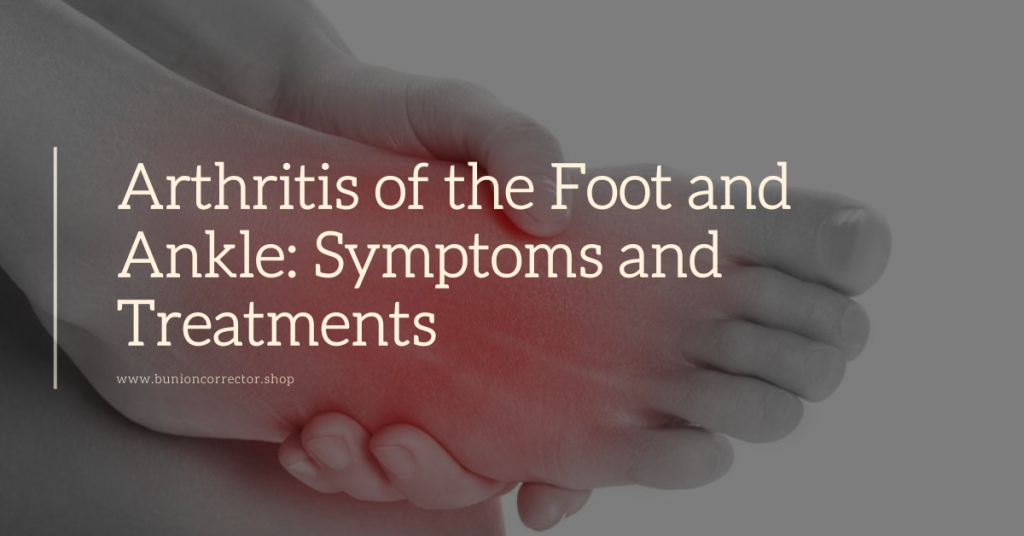Arthritis is a term we hear often, but it can be excruciating and limiting when it affects the foot and ankle. Our feet and ankles carry us through life, and when arthritis strikes in these areas, simple activities like walking, running, or even standing can become excruciating. In this guide, we’ll explore what arthritis of the foot and ankle is, the different types, how it affects your daily life, and most importantly, what you can do about it.

What is Arthritis of the Foot and Ankle?
Arthritis is a condition that causes inflammation in the joints, leading to pain, swelling, and stiffness. In the foot and ankle, arthritis can make movements difficult and painful, significantly impacting mobility and quality of life.
Arthritis of the Foot and Ankle: The foot has 33 joints, and the ankle comprises three bones that form a hinge joint. With so many bones and joints working together to support our body weight, the foot and ankle are prone to wear and tear, making them common targets for arthritis.
Types of Arthritis that Affect the Foot and Ankle
There are several types of arthritis that can affect the foot and ankle, each with its own causes and symptoms. Understanding the type of arthritis you have is the first step toward managing it effectively.
- Osteoarthritis (OA)
Osteoarthritis is the most common type of arthritis. It is often called “wear-and-tear” arthritis because it occurs when the protective cartilage that cushions your joints wears down over time. This results in bone rubbing against bone, which causes pain, swelling, and loss of motion.
In the foot and ankle, osteoarthritis can develop due to aging, previous injuries, or repetitive strain. It is most common in the big toe, ankle, and midfoot joints.
- Rheumatoid Arthritis (RA)
Rheumatoid arthritis is an autoimmune condition where the body’s immune system mistakenly attacks healthy tissue in the joints. Unlike osteoarthritis, RA can affect multiple joints simultaneously, including those in the foot and ankle.
RA often leads to severe inflammation, pain, and joint deformity, particularly in the toes and the arch of the foot. People with RA might also notice swelling and redness around the affected joints.
- Post-Traumatic Arthritis
This type of arthritis develops after an injury, such as a sprain, fracture, or dislocation. Even if the injury heals properly, it can cause damage to the cartilage in the joint, leading to arthritis over time.
Post-traumatic arthritis is joint in athletes or individuals who have had foot or ankle injuries in the past. The symptoms are similar to osteoarthritis, with pain, swelling, and stiffness being the primary concerns.
- Gout
Gout is an inflammatory arthritis caused by a buildup of uric acid crystals in the joints. It often affects the big toe joint, causing intense pain, swelling, redness, and warmth. Gout attacks can come on suddenly and be extremely painful, but they usually subside with treatment.
Arthritis of the Foot and Ankle Symptoms
The symptoms of Arthritis of the Foot and Ankle can vary depending on the type of arthritis you have. However, there are common signs to watch out for that may indicate the onset of arthritis in these areas:
- Pain: Pain is usually the first symptom. It may worsen after physical activity or at the end of the day.
- Swelling: You may notice swelling around the affected joints, especially after periods of activity or standing.
- Stiffness: Arthritis often leads to stiffness in the joints, making it difficult to move your foot or ankle comfortably.
- Limited Range of Motion: As arthritis progresses, you might find bending or flexing your foot and ankle harder.
- Difficulty Walking: The pain and stiffness can make walking or standing difficult, limiting mobility and independence.
- Joint Deformity: Over time, severe cases of arthritis, particularly RA, can cause visible deformities in the foot and ankle.
Diagnosing Arthritis of the Foot and Ankle
If you are experiencing persistent pain, swelling, or stiffness in your foot or ankle, you must see a healthcare professional for a diagnosis. Early diagnosis and treatment can help manage symptoms and prevent further damage.
What to Expect During a Doctor’s Visit
- Medical History: Your doctor will ask about your symptoms, previous injuries, and family history to better understand your condition.
- Physical Examination: Your doctor will examine your foot and ankle, checking for swelling, pain, and range of motion.
- Imaging Tests: X-rays, MRIs, or CT scans may be used to get a clearer picture of the affected joints and to assess the severity of arthritis.
- Blood Tests: In cases where rheumatoid arthritis or gout is suspected, blood tests may be done to check for inflammation markers or elevated uric acid levels.

Treatment Options for Arthritis of the Foot and Ankle
While there is no cure for arthritis, several ways exist to manage the symptoms and improve your quality of life. Treatment plans typically focus on reducing pain, improving mobility, and preventing further joint damage.
1. Non-Surgical Treatments
Non-surgical treatments are often the first line of defence against arthritis. These may include:
- Medications: Over-the-counter pain relievers, such as ibuprofen or acetaminophen, can help manage pain and reduce inflammation. For more severe cases, prescription medications or corticosteroid injections may be recommended.
- Physical Therapy: A physical therapist can teach you exercises to strengthen the muscles around your foot and ankle, improve flexibility, and maintain range of motion.
- Orthotic Devices: Custom-made shoe inserts, braces, or supportive footwear can help relieve pressure on the affected joints and make walking easier.
- Lifestyle Changes: Maintaining a healthy weight, avoiding high-impact activities, and eating a balanced diet can help manage arthritis symptoms. Losing weight can reduce the strain on your joints, especially in the feet and ankles.
2. Surgical Treatments
If non-surgical treatments aren’t effective in relieving symptoms, surgery may be necessary. Some surgical options include:
- Arthroscopy: A minimally invasive procedure that involves cleaning out the joint to remove damaged cartilage or bone fragments.
- Joint Fusion (Arthrodesis): In this procedure, the affected joint is fused, eliminating pain and limiting movement in the joint.
- Joint Replacement (Arthroplasty): In severe cases, the damaged joint may be replaced with an artificial one to restore mobility and reduce pain.
Living with Arthritis in the Foot and Ankle
While arthritis is a chronic condition, many people lead whole, active lives with the proper treatment and lifestyle adjustments. Some tips for living with Arthritis of the Foot and Ankle include:
- Stay Active: Gentle activities like swimming, cycling, or walking can keep your joints flexible and muscles strong without putting too much strain on your feet and ankles.
- Wear Comfortable Shoes: Wear shoes with good arch support and a wide toe box to reduce joint pressure.
- Use Assistive Devices: If walking is painful, a cane or walker can help reduce the load on your joints and improve your balance.
- Rest When Needed: Don’t overdo it—take breaks when you need to, and listen to your body when it signals pain or fatigue.
Conclusion
Arthritis of the foot and ankle is a common yet often overlooked condition that can significantly impact daily life. Early diagnosis and a personalized treatment plan can help you manage your symptoms and maintain mobility. Whether through medication, physical therapy, or surgery, there are many ways to find relief and continue living life on your terms.